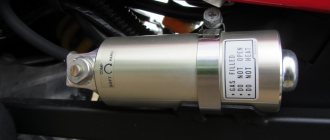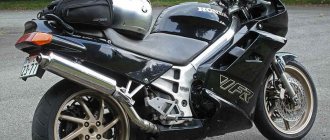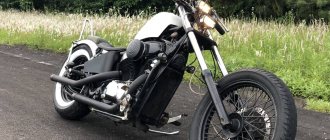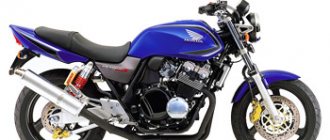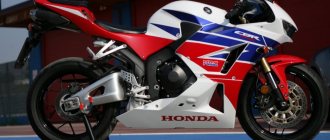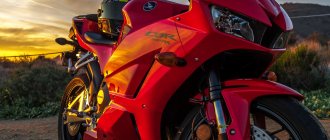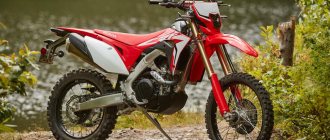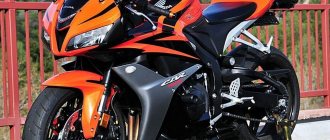Motorcycle Honda CBR 600 F4i has become one of the most successful models in the entire line of sports “six hundred” from . Its creators managed to find the perfect balance between design, technical characteristics, comfort, seasoning it all with branded reliability, and the cherry on the cake was moderate cost. The bike is still in great demand on the market, despite the fact that it has been discontinued for a long time - the updated model that replaced it has become a more radical sports bike, and because of this, it has lost some of the fans who are accustomed to using the Honda F4i Sport not only as a motorcycle for every day, but also as sports tourist. Indeed, this model is quite capable of long-distance travel, especially if you equip it with suitable tuning and plan a route along roads of normal quality.
Design
Taking the appearance of the carburetor F4 as a basis, Japanese designers slightly modified it, adding smoothness to the lines. As a result, the bike, which was outdated in appearance, sparkled with new colors, and it looks organic on the roads even now. The commercial success of the model, which was produced for five years, is largely due to its daring appearance with a massive front end and predatory contours of a plastic body kit. Although globally the design has remained virtually unchanged since the release of the Honda SBR 600 F2, that is, since the early 90s. But in F4 Ai it was revised, refined and adjusted to the changing requirements of capricious fashion.
History of changes
The Honda 600cc received its first modernization 2 years after the start of production - in 2005. The appearance has changed, the geometry of the aluminum frame, the front and rear brake calipers have become radial. The front fork and rear suspension have new geometry and a full range of adjustments. The Honda CBR600RR has become 4 kg lighter, and the engine has increased traction at mid-speed.
In 2007, engineers developed a new Honda 600 motorcycle engine, significantly lighter and more compact. The frame was narrowed a little, and the weight was also reduced by 9 kg. The appearance and aerodynamics have been improved again. The steering wheel began to be equipped with an electronically controlled damper.
Since 2009, the developers, by modernizing the pistons, cylinder block and exhaust system, have increased traction at high speeds, and began to offer the installation of ABS as an option.
In 2013, tuning of the wheel rims took place. The new engine control program allowed it to produce even more thrust. The front fork was replaced with a new Showa, the rear suspension of the Honda SBR 600rr received updated settings.
Honda CBR600RR, Honda 600cc
Specifications
Strictly speaking, it was the Honda CBR 600 F4i Sport that became the latest modification in the line. After the cessation of its production, the company fell silent for five long years, after which it offered the buyer a completely new CBR 600 F, which has practically nothing in common with its predecessor, except for the name. At the same time, the capabilities of the old F4 are comparable to those of modern competitors, and on the road it will not yield to them. It's simple - for the Honda CBR600F, the technical characteristics were designed mainly by marketers, and for the previous model they were developed by engineers who thought about how to reduce production costs, not in the first place.
Engine
The Honda CBR600F4i engine was borrowed from the previous generation and is almost no different from it, with the exception of an injection power system instead of a carburetor. This is a proven in-line four with liquid cooling , even the power has not changed - 110 hp, 62 Nm of torque . The engine loves speed, and to achieve optimal dynamics it needs to be turned up to 10-12 thousand revolutions, but at the “bottoms” it also behaves tolerably, without the twitching characteristic of forced engines of small cubic capacity at the slightest turn of the throttle. Acceleration to 100 km/h takes, according to various sources, from 3 to 3.5 seconds , that is, the difference is within the error.
Transmission
The gearbox is also carried over from the Honda CBR600F4. This is a classic 6-speed transmission , operating absolutely silently and extremely clearly. Reviews from owners often mention that with timely maintenance, the unit does not cause problems at all, and many of them, over a hundred thousand kilometers, only had to change the clutch, which is actually a consumable.
Chassis and brakes
The alloy frame replaced the steel frame back in the days of production of the carburetor generation, and it went to the Honda CBR600F4i without any changes, which had a positive effect on the weight of the motorcycle. The brakes have also not been changed since the late 90s; the front wheel has two 296 mm discs with 4-piston calipers , and the rear wheel has one 220 mm disc with a 1-piston caliper. Unfortunately, ABS system is not provided , but in general the braking system is sufficiently effective. Moreover, the suspensions contribute to excellent handling, especially with proper tuning. The designers were generous with a fully adjustable 43 mm inverted fork and a rear monoshock (both produced by the famous HMAS brand), also with a full range of adjustments.
Electronics
The Honda CBR600F4i was produced at the beginning of the 21st century, when auxiliary systems had not yet been introduced into all components where they could be implemented. There are no “smart assistants”, traction controls, different engine operating modes and the like here – just good old mechanics with the necessary minimum of electronic components. In case of potential problems, this greatly simplifies troubleshooting, and there is no need for computer diagnostics at the dealer.
Weight and dimensions
The sportbike's curb weight is lower both than that of its predecessors and that of its successor, the CBR600F Sport, only 200 kg . This is not a record, but a decent indicator, so the power output of this model is not bad. And the ergonomics, thought out to the smallest detail, make it very convenient for bikers of any size, although especially tall motorcyclists should think about installing a higher windshield, otherwise they will face a powerful flow of wind into the helmet, from which they can only hide by lying on the tank.
Controllability
Ease of control is one of the strengths of the model. The Honda CBR 600 F4ai steers very easily and predictably, and this is not the case when “predictable” means “boring”. The sportbike maneuvers well both at minimum speed and at 150-180 km/h, and what sets it apart from most other sporty 600s is the smooth behavior of the engine at low speeds, which is very important for city driving.
Fuel consumption
According to official data, average gasoline consumption falls slightly short of 6 liters . In practice, this figure may differ significantly, both up and down. It all depends on the technical condition of a particular motorcycle, your riding style, fuel quality and a number of other factors. But for simplicity, you can focus on this figure.
Honda CBR600F design
The first three generations (~ 12 years) the model was assembled on a tubular steel frame.
The photo shows a 1994 Honda CBR600 F2 (2nd generation) on a steel frame with a square headlight.
A double pipe was used to strengthen the structure. In 1999 the material changes to aluminum . The design is the same - tubular. Only the new model, launched after the break, began to receive a cast frame.
- Rear suspension was produced according to the standard principle - mono shock absorber + swingarm. Over 18 years, the working progress has increased from 110 to 120 mm.
The latest generation rear suspension is based on an aluminum Dual Box swingarm paired with a Monoshock shock absorber.
- The front has changed from generation to generation. During evolution, the diameter of the fork feathers increased by 5 mm, before 43 mm on the fourth generation. The first versions were equipped with a standard version. Starting from the third generation, since 1995, Honda’s own design appeared on the motorcycle - a fork HMAS. The changeling appeared only in the latest versions based on the road-going Hornet. During production, the ability to adjust the suspension on your own also underwent changes from zero on the first generations to full on the fourth and fifth.
The front fork absorbs road imperfections well and provides the right level of kickback for safe cornering.
It’s interesting that when production was resumed, the suspension was cut in all respects. The diameter of the feathers became smaller, adjustments were reduced to a minimum, and the working stroke of the shock absorbers also became smaller.
As part of the new generations, the motorcycle received various goodies and additions, the most important of which was the replacement of the carburetor with an injector in the latest, fifth version
Exterior
Despite its sporting purpose, the motorcycle is quite comfortable to drive, and a full set of optics, mirrors, space for a second number plate and even a small offset sufficient for installing a trunk allows it to be used as a sports tourer.
Left view.
Right view.
An additional advantage is the presence of a PTS, and therefore the ability to register, which will allow it to be used on additional roads.
Front end
- It is quite easy to distinguish a Hurricane from a Hornet - by the headlight. The most popular, fifth generation ( 2001–2006) has a claim to "fox eyes" The tourist has one irregularly shaped headlight. The first versions of the bike also had one headlight, but in a square design.
Honda CBR600F Hurricane with two headlights.
Honda CBR600F Hornet with one headlight.
- Fox eyes, rather a prop, are clearly visible behind their glasses round reflector of a regular lamp. They turn on as standard, for the near one one eye, for the far one - both. The headlights are inserted into a large body kit, the top of which is crowned by the windshield. But it is small, designed for a sporty fit. When sitting according to the classics, it is not enough.
A distinctive feature of all Honda CBR600F models is a full aerodynamic body kit.
- The mirrors are large and square in shape . They are the most protruding part, so be careful when traveling in traffic. Although they are located high, the overall low stance of the bike lowers them to the level of the “ears” of passenger cars. The developers deviated from the standards in the design. The mounts are not on the body kit, as is customary with Honda, but on the steering wheel. This expands the customization options, allowing the rider to turn them so that they can see the road situation, and not their limbs.
- The turn signals are traditional - yellow “candles” on stands attached to the side edges of the body kit . They are located quite low, at the level of the lower part of the body kit. The latter descends almost to the wing, the technological opening for air intake is minimal. The wing itself also changed during evolution until it took on a non-standard, stepped (when viewed from the front) appearance. The main part is pressed tightly against the tire, the steps on the sides are a kind of covers for the fork legs.
Dashboard
The modern design of the “tidy” allows you to literally control the speed and number of revolutions at a glance.
The main data is presented here in two blocks. Pointer tachometer (marked up to 17 , red at 14.5 , recommended at 12 ) x1000 . It has a built-in temperature indicator. The second block is a large LCD screen.
After a standard startup check it displays:
- clock and indicators for oil availability and engine temperature (the latter with a pair of icons);
- fuel indicator and speed (standard – bar and numbers);
- trip 1, trip 2 - the last few mileage readings (adjustable using the buttons to the left of the screen).
While driving, the display shows information about current and average fuel consumption.
The same block includes other indicators, made in one line. Among them:
- turn indicators;
- neutral;
- turning on the high beam;
- self-diagnosis lamp;
- An interesting feature is the presence of a blinker (a blinker indicating that the speed limit for Japan has been exceeded) - the model was not officially sold in Japan.
The ignition key is slightly lower, the well is covered with a curtain.
The ignition key can be removed from the lock in the OFF or LOCK position.
According to user reviews, the devices are more than sufficient; the main data (speed/rpm) can be caught at a glance . When errors occur, the indicators light up very brightly, and the self-diagnosis light (labeled F1) indicates by the number of blinks where to look for the problem.
Back view
The optics are presented in a complete set. The same turn signal bulbs as the front and brake lights in the same housing with dimensions.
Rear optics.
Exhaust system muffler.
- The bike's saddle has also gone through some evolutionary path from common for two passengers to separate perches. Both options found their use in 2001.
- Models of recent years have one saddle, which is clearly divided into two parts. Due to their specific tilt, the second number can look over the driver’s head.
Gas tank
There is a keyhole hidden under the flap on the neck of the gas tank; the key is the same as for the ignition switch.
The gas tank is large, holds 18 liters . (latest editions). Located in a standard place, but the design is not very convenient. Due to the pronounced angle near the driver, sitting in a sporty style can be a problem for tall motorcyclists.
Motorcycle price
This model was produced from 2001 to 2006 , so the most recent copies are still almost a decade and a half old. So the price on the secondary market is low, 95% of offers are in the range from 200-220 to 300-330 thousand rubles . You need to choose very carefully - despite excellent reliability, a motorcycle still does not last forever, and in the hands of a careless owner it can quickly turn into junk on two wheels, and over the past years, the sportbike that you like has probably passed through many hands.
Where to buy?
The technical characteristics of the Honda CBR 600 F4i are the first thing you should pay attention to when buying a bike. Judging by the reviews, finding a model in decent condition is not so difficult
Moreover, this applies only to models imported from abroad and those that have managed to get acquainted with domestic roads. Due to its mild nature and relatively low power, this bike is not as attractive as the more recent RRs that both beginners and serious racers like to look at.
Most often, the F4i is used as a vehicle in city traffic or as a long-range vehicle, as evidenced by numerous reviews. Due to these features, even used motorcycles retain their original characteristics. The CBR is not often the first to be purchased, so the motorcycle rarely encounters improper and extreme use, which cannot be said about the “four hundred”.
The price tag ranges from 180 to 320 thousand rubles. There is no correlation by year of release as such. The 2004 model may be a lot worse than the 2002 Honda CBR 600 F4i.
Selling a motorcycle, by the way, is also easy. With its characteristics and versatility, a buyer will be found very quickly, if, of course, you do not overdo it with the price of the device.
Repair and tuning
Affordable maintenance costs and ease of maintenance are another reason why this motorcycle is so popular. Not everyone has the desire or ability to spend money on visits to branded services, but this bike provides all the opportunities to do it in your own garage.
Repair
Honda TsBR F4 is a representative of an almost extinct class of fully repairable motorcycles. Almost all of its components can be repaired, and not simply replaced, unlike more modern technology. Do-it-yourself repairs are entirely possible if you have the appropriate skills. As a last resort, you can always contact any normal motorcycle service.
Spare parts
Most of the spare parts are suitable for the CBR 600F4, since the engines, gearboxes, chassis and many other components of these bikes are almost identical. Over the years of production, the Japanese company has riveted a huge number of models, so in general there are no problems with finding parts. You can always order new spare parts, original or not, or look for used ones, of which there are also plenty.
Tuning
There are a huge number of available tuning options; different companies offer interesting solutions even now, despite the fact that the Honda CBR600F4i has not been produced for a long time. Quickshifters, luggage systems, windshields, firmware for injectors - you can buy anything you want, not to mention little things like grips, mirrors, sliders and similar little things.
Italian packaging
Sportbikes are traditionally considered the focus of high technology and unique solutions tested by companies in the world of big-time motorsports. This is exactly the battlefield where every motorcycle concern strives to implement its know-how in order to make products lighter, faster, more stable and “smarter”. At the same time, not forgetting to keep the cost of the models at the level of competitors - otherwise this entire perfect and revolutionary motorcycle will remain the lot of professional racers and their wealthy sponsors. In terms of technical equipment and sophistication, the device from MV Agusta is the clear leader among the test trio!
There is an in-line 3-cylinder engine with a crankshaft rotating in the opposite direction, like in MotoGP cars, and titanium valves “all around”, and “gas” by wire, and two fuel injection system nozzles per cylinder, and valves with a record diameter of 50 mm... The motorcycle is built on the basis of a combined type frame, the main part of which is made of steel pipes, but there are sections made of aluminum. The F3 model is also “packed” with electronics right up to the crankcase. The Italian manufacturer has combined all the numerous assistance systems into one abbreviation MVICS, which stands for Motor & Vehicle Integrated Control System. This word salad includes an 8-level traction control system and the ability to switch between four preset engine programs.
As always, the Italians have not forgotten about the possibilities of customizing a motorcycle. The catalog of optional equipment on the F3 contains not only an extensive list of “Khokhloma” in the form of priceless carbon parts, milled footrests and polished engine covers, but also, for example, a proprietary quickshifter, which is programmatically deactivated through the dashboard menu - even if the device itself is not installed, this function already exists. Just in case…
Advantages and disadvantages
The Honda CBR600F4i turned out to be a very balanced motorcycle , but it shows an attempt by the designers to flirt with both the sportbike class and the sport-tourist class at the same time. But the result of this bold experiment turned out to be very worthy, although not without some specific shortcomings.
Advantages
- Incredible reliability . 100 thousand kilometers for this engine is far from the limit.
- Spacious gas tank , as much as 18 liters. On a long journey, you can safely count on a range of up to 300 km, if you don’t drive too fast.
- Excellent dynamics , comparable to the dynamics of “liter” sportbikes.
- Standardization with many other Honda models on a number of components, which makes it easier to find spare parts.
- level of comfort by class standards .
Flaws
- Lack of ABS , which does not go well with impressive dynamics.
- Weak light from the headlight . Most owners eliminate this drawback by replacing standard optics with xenon, but this is fraught with problems with the traffic police.
- When driving through traffic jams in the heat, the engine gets noticeably hot . He is not in danger of overheating, but his legs get hot.
- Small steering angle , which makes maneuvering at near-zero speeds difficult.
Flaws
After the developers’ statement that they studied all the problems of the class on competitors’ models, you don’t expect any problems from the bike. But Honda distinguished itself with this model.
Each user notes the high cost of branded consumables: “ It’s not a problem to get them, but they are expensive .”
Advantages
There are many more advantages:
- power;
- convenience for the city;
- possibility of registration with the traffic police;
- large trunk;
- heated handles (out of the box);
- strong brakes.
Owner reviews
An excellent bike, comfortable and convenient, after traveling 800+ km with short stops at a gas station, I didn’t even have the desire to warm up, nothing stiffened or hurt. The standard windshield is enough for my height (174 cm), up to 160 mph you can’t even lie on the tank, and it doesn’t blow. The seating position is close to classic, the load on the back and arms appears only when lying on the tank, that is, when driving at very high speeds, and I don’t drive like that. My cruiser on the highway is about 150-160, if you drive faster, fuel consumption increases sharply, but it fits within 6 liters quite well. I always use 92nd grade gasoline, everything is ok, preventive cleaning of the injector showed that the gasoline is good, no dirt was found. Sergey, Rostov-on-Don.
The model is ideal in many respects - the engine is torquey, comes to life after 7000 rpm, the suspension is complete stuffing with a set of adjustments, there are also enough brakes. If this model were still in production, I would take a new one without hesitation. I changed the bike myself in 2022, tried a tourenduro - it didn’t work for me, I started looking at sports again. The more recent Honda 600F didn’t work at all; I ended up taking the Fyzhera 1300, but it’s already a heavyweight compared to the F4i. Grigory, St. Petersburg.
I took it as my first moto, although I knew that it was not a toy, so I rode carefully. The first impression was not very good - the motor is rolly at low speeds, the engine is torsional, I was scared at first. Gradually I got used to it, began to fry it to the fullest, in three and a half seasons I wound up almost 40k, I drove with panniers at sea, and around Kazakhstan, and wherever I went. There were no serious breakdowns during the entire period, only minor ones that were inevitable due to the age of the bike. Alexander, Kazan.
Characteristic features of the unit
The aerodynamic characteristics of this model are pragmatic - oncoming air flows are not just dispersed, they are absorbed by the front air intakes, which significantly improves the responsiveness of the carburetor throttle. And the combined, aggressively smooth relief of all fairings creates a certain futuristic appearance of the motorcycle and the “rider” sitting on it. And even the passenger in the back does not spoil the picture at all - he has the same landing position as the pilot. Everything looks very organic and seamless.
Anyone who has an obvious or hidden love for bikes, riding the CBR f4i, will not miss the opportunity to bring the tachometer needle to 10,000 rpm. And only then will he think about the possible need to brake sharply. But this is all right: 4-piston brakes, double-disc in front and single-disc in rear, are many times more sensitive and at the same time more effective than their predecessors.
Not without criticism, of course... Particularly picky “users” express dissatisfaction with the lack of rear visibility. This refers to the rear view mirrors. Although, it’s true, they could be spaced horizontally a little more, increasing the length of the mirror holders by at least a centimeter each. The convex protective covering of the speedometer and tachometer also causes criticism - in bright sunshine, the readings of these instruments are almost invisible due to glare. The same applies to the LCD daily mileage counter, which without a mirror backing - in daylight - its readings are not visible. But even more discomfort when driving is caused by the absence of a fuel level indicator (there is only a reserve capacity sensor). Despite the general focus of such equipment on convenience and comfort, the underseat luggage rack is very small, which does not allow you to carry something bulky with you.
Similar models
- Kawasaki ZX-6R. extremely popular sportbike that has gone through countless restylings and upgrades.
- Yamaha XJ6 Diversion F, also known as FZ-6R. An easy-to-handle and easy-going road warrior in the guise of a sports motorcycle.
- Suzuki GSX-600R. A much more “angry” and radical bike , which was created primarily for the race track, and not for everyday riding.
Can't refuse
Making a choice in favor of one motorcycle or another is always difficult - even if we are not talking about buying equipment, but about evaluating the devices compared in the test. As you know, the level of competition in the global market is so high that it would be foolish to assume that any of the major motorcycle manufacturers would allow themselves to make a frankly shoddy product: all three sportbikes participating in the comparison are worthy of taking a place in your garage, and none of the motorcycles will disappoint even the most demanding amateur athlete. But professional racers still do not use standard models and necessarily modify their equipment. In my opinion, the CBR600RR is the most balanced model, which has everything for both track use and, if you like, city driving. To some, the Honda device may seem “gray” and inexpressive... Perhaps. The CBR600RR has no obvious “talents”, and all its qualities are averagely good, but this is what makes driving the Japanese sportbike simple and safe.
Yamaha YZF-R6 is the most characteristic motorcycle designed exclusively for sports use. A kind of Subaru rally prototype, obstinate and controversial, which due to some bureaucratic misunderstanding was allowed for use on public roads. The MV Agusta sportbike is Italian luxury, beautiful in everything: from form to content and from engine performance to sharp handling. You want to own a motorcycle like this, you want to ride it—it’s like love at first sight! And, of course, the feeling of driving the F3 model, which is fundamentally different in many ways from Japanese cars, cannot be confused with the feeling of driving any “rice” machine. Italy is still different: better in some ways, vice versa in others, but certainly not boring!
Before concluding this review, we cannot help but mention the price. Everything is expected here: Japanese sportbikes cost the same plus or minus, and an Italian car is almost 100,000 rubles more expensive... But here’s an unexpected remark: at the time of writing this text, the official dealers of MV Agusta equipment had a very “tasty” offer - all F3 motorcycles , available in Russia, were sold for 597,000 rubles! That is, only 10-20 thousand rubles more expensive than the Honda CBR600RR and Yamaha YZF-R6... And here, forgive me, the “Japanese” simply have no chance. /
FAQ
- How does it differ in fuel consumption compared to the carbureted F4? Insignificant, on average within 0.5-0.7 liters.
- With a height of 196 cm, won’t it be tight on him? In general, no, judging by the reviews of the owners. But in this case, you should immediately look for a windshield of increased height to avoid discomfort.
- I heard that its suspension is too soft for the track. This is true? Not really. Of course, this is not a radical sportbike like the Yamaha YZF-R1, but the suspension can be tuned to become much stiffer.
Competitors
In addition to the already mentioned Yamaxa R6 , comfortable only for tall pilots.
The developers also mention Ninja ZX-6R , as well as Suzuki's GSX-R 600 . In terms of comfortable fit, they are no different from Honda.
Managers admitted that competitors have slightly better acceleration characteristics, but clarify that not one of them turns so well . Thanks to the later release, all the disadvantages were studied on competitors.
Conclusion
This model is a rare example of a successful experiment at the junction of two classes . Powerful enough and well-equipped for the track, it is perfect for the role of a motorcycle for every day, and it can handle long journeys too. Of course, it has its shortcomings, but they pale in comparison to its many advantages. Perhaps the only serious disadvantage of the Honda CBR600 F4i is the considerable age of all copies.
Specifications
| Maximum engine power: | 110.2 hp (81 kW at 12500 rpm) HP |
| Torque: | 10500 rpm (65 Nm) Nm |
| Working volume: | 599 cm3 |
| Motor type (cylinder arrangement, number of strokes): | In-line four-stroke engine |
| Number of cylinders: | 4 |
| Number of valves: | |
| Intake type (Injector / Carburetor): | |
| Bore and stroke: | |
| Starting system (Electric starter, kick starter): | |
| Maximum speed in km/h: | 251 km/h |
| Cooling system: | Liquid cooling fan |
| Transmission (gearbox): | 6-speed, Manual |
| Clutch (Dry / Wet): | |
| Drive unit: | Chain |
| Frame: | Aluminum twin-spar, box-section |
| Chassis | |
| Suspension (front/rear travel): | |
| Brakes (Front/Rear): | |
| Wheels / Tires / Rubber: | |
| Dimensions and weight | |
| Dimensions (Length / Width): | |
| Seat height: | |
| Ground clearance: | |
| Curb weight: | |
| Wheelbase: | 1390 mm |
| Weight: | 200 kg |
| Fuel tank capacity: | 18 l. |
| Battery capacity: | |
| Year of release: | |
| Country of Origin: |
Modifications
Starting in 1991, the model began to gradually transition into the category of tourists, and the developers had to think about a sports version.
All changes in the sports version concerned reducing the weight of the motorcycle.
In 2001, simultaneously with the launch of injection versions, the CBR600F F4 Sport . The amount of plastic on the model was reduced, and the center stand was also removed. This allowed the overall weight to be reduced by several kg.
But it should also be noted that American traffic rules require you to indicate speed in miles. But reconfiguring the control unit for km is quite simple from authorized Honda representatives. Temperature readings are also easy to switch, and the gauges work equally well without any additional adjustments.
